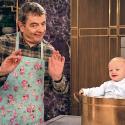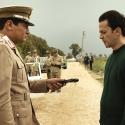What if John Lennon had left The Beatles in 1962? What if they had continued without him? And what if he had still become the acid-tongued, ready-with-a-quip character the real world became familiar with? Snodgrass took those what-ifs and ran with them to depict a parallel world that was less the “hilarious comedy drama” trailed by Sky and more a gloomy, slightly creepy oddity made even more so by Ian Hart’s deft, second-nature portrayal of a Lennon floundering on life’s scrapheap.
Hart has played Lennon twice before and this third outing took him into an imaginary scenario originally created by the writer Ian R MacLeod. The television adaptation was by David Quantick. In short-story form, Snodgrass was a first-person narrative with the alternative Lennon navigating his path through the day-to-day with a caustic outlook as resentful as it was acerbic. Bringing it to life for television with evocative new music by The Boo Radleys' Martin Carr caught the flavours faultlessly.
Despatched by the job centre to a drudge job in an office, he seeks attention while taking the bus there. After arriving, dim bulbs of recognition flicker into life: “You’re the guy who left The Beatles”; “Of course, The Who and the Stones were the ones for me.” He remarks: “We could have been bigger than The Hollies.” The men he dislikes are all called Snodgrass, the women Doris. The job is over in less time than it took him to get there.
As Lennon, Hart was stunning, making this illusion believable
It’s 1991. The radio news dwells on the death of media magnate Robert Maxwell. John Lennon lives in Birmingham. Jobless, he’s behind with his rent and sports the round glasses and centre-parted hair of the late Sixties and early Seventies. Living in the house of a younger woman and an unseen man, his mouth issues streams of one-liners that could be funny had he a platform from which to deliver them. Instead, he’s borderline pathetic.
As Lennon, Hart was stunning, making this illusion believable. But the inherent contradiction central to Snodgrass almost cancelled out its reason for existence. If Lennon had left The Beatles and if they had been no bigger than, say, their near contemporaries The Fortunes (who had hits in the Sixties and Seventies like Snodgrass’s Beatles), no one would be interested in what became of him – no one would be writing about what become of John Lennon. Snodgrass is predicated on knowledge of the real Beatles, with this Lennon a fictive counterpart to the real-life ousted Beatle Pete Best. No real-life Beatles, no Snodgrass.
A poster is seen for the Lennon-less Beatles, in town trudging through the nostalgia circuit. Billed as playing their greatest hits, their repertoire includes the song which caused him to leave: “How Do You Do It”. "Yellow Submarine” and “Yesterday” are listed too, as are gems from the real solo George Harrison, Paul McCartney and Ringo Starr catalogues like “Ding Dong”, "Mary Had a Little Lamb”, “C Moon”, “Mull of Kintyre and “You’re Sixteen” – the schlockiest of the actual Beatles and post-Beatles. On coming home, Lennon is told that McCartney visited, to say he was right, they never should have recorded “How Do You Do It”.
As an intellectual exercise, Snodgrass hit the target. But as entertainment, the uneasiness it triggered made for a less than comfortable experience.














Add comment